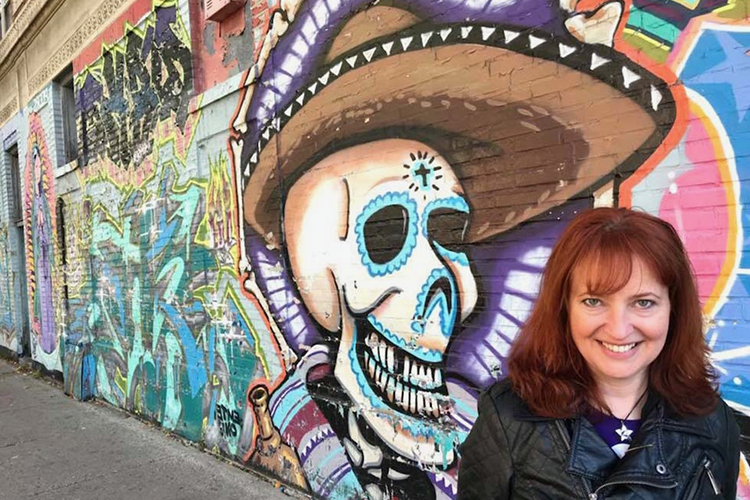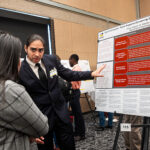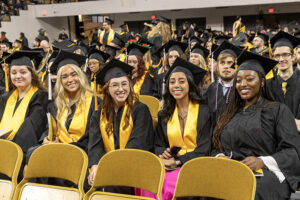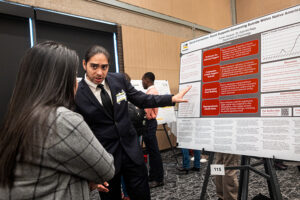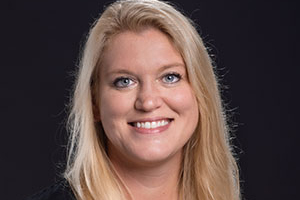Allison Jornlin is a writer, a ghost hunter and, in her own words, a professional weirdo. She’s also the tour developer for American Ghost Walks, a family business that takes guests on haunted history tours of cities in Wisconsin, Illinois, Minnesota, Maine, Louisiana, California, Hawaii and Puerto Rico.
Before that, however, Jornlin was a UWM graduate. A native of Big Bend, Wisconsin, she chose UWM because she wanted to stay close to home. She majored in English but also enjoyed taking classes in American Indian Studies, especially those taught by the late professor John Boatman. After graduation, those classes eventually helped her land a spot as a teacher at the Indian Community School in Franklin, Wisconsin. She taught for 13 years before leaving teaching to research and write about hauntings full-time.
With a deep appreciation for Milwaukee, its history, and its ghosts, Jornlin sat down to talk about American Ghost Walks – just in time for Halloween.
How did you start creating haunted history tours?
The first haunted history tales that I loved were from Richard Crowe, who developed one of the first haunted history tours in the nation in Chicago in 1973. My mother loved listening to the Chicago radio stations. Every Halloween she would gather me and my little brother around the radio to listen to Richard Crowe spin tales of haunted Chicagoland. It’s one of my favorite memories.

I decided well, (as a teacher) I now have summertime off so I can research the history of Milwaukee. I was able to go to the Historical Society and every little library around and collect stories. I put together a haunted history tour of the Third Ward in 2008. It’s still going. This inaugural tour eventually led to the founding of the family business we have today.
A couple years later, when my brother was looking for a way to pay his mortgage, I said, why don’t you do a haunted history tour of Madison? He really built American Ghost Walks into the successful company it is today. When it was time, we both quit our jobs and now our tour company is in seven states and Puerto Rico.
What sets American Ghost Walks apart from other ghost tours?
We keep working on it and entering more states which is really fun, because then you get to learn about the heritage of different areas of the country. We don’t just tell any ghost stories; we tell ghost stories that are connected with the history and the heritage of a place and the people that called that place home.
For example, Kennebunkport, Maine, is one of the tours that we resurrected for this season. I had such a fascinating time delving into its history. There are a lot of writers that used to summer there, like Booth Tarkington. He wrote a book called “The Magnificent Ambersons,” which was directed as a film by Orson Welles. But the fascinating thing about him that people, even locals, don’t recognize is that he grew up in spiritualism and had many extraordinary experiences with the spirits.
That’s an example of the kind of subject matter we focus on. We don’t want to just give the history and then the ghost stories separately. We can bring about some greater understanding of not only the local people, but of historical movements, like the spiritualist movement. I think that’s important because, for example, the spiritualist movement was a big proponent of abolition and women’s rights. A lot of people don’t realize how ahead of their time spiritualists really were. Of course, we’re interested in modern day manifestations of these things as well. But I think people need to understand the history first.
What goes into creating a successful tour?
(It’s) important to walk the route that you’re thinking of, because many of our haunted history tours are walking tours. When you’re doing a walking tour, it’s challenging because the tour can only be about a mile. You want it to be a nice, relaxed stroll that takes people past several locations, looping it if possible so it will take them back to the beginning. So, it’s challenging to find enough stories that connect in a one-mile radius.
(As for writing a tour script,) there’s a lot of archival research, a lot of looking at old newspapers. Certainly, actually visiting the place is very important, and talking to people at the local library and the historical societies there. Not all of the interesting stuff is online. I look over documents to find a narrative that will connect stories.
How do you find haunted places to feature on your tours? Is it simply a matter of asking the locals, “Where are your ghosts?”
Well, that can be a challenge, because certainly there are lots of people that turn you away and look at you askance for even suggesting such a thing. But going door to door is part of the process. What I like to do is look into historical sites and hauntings that come up in old newspaper articles and other documents, and then you can walk around and talk to people in that area. So I am digging things out of history, then seeing if they’re still relevant. A lot of times they are.
What do you say to the skeptics who don’t believe in ghosts or hauntings?
In many ways, ghost stories are a sacred thing to people. I mean, it’s fun, don’t get me wrong! I know, during the Halloween holiday especially, people like to joke about ghosts, but to lots of people, experiences with the departed or other entities in the spirit world have sacredness. That shouldn’t be overlooked.
In our society at large, we’re taught not to believe in these things, and that science has the answer for everything. Science is great. My dad was a high school science teacher. Science is very much something that’s important to me as well. But there are things beyond science that many people have experienced. And in this society, there’s not really a way to learn about these things. Our haunted history tours are one way people can reconnect with the spiritual types of learning.
You’ve got a successful haunted historical tour company and Halloween is coming up. We can’t end this interview without a good Milwaukee ghost story.
My favorite story from our Third Ward Tour is about Clair Richardson, who was the founder of the Skylight Theatre. He died in 1980, but he was a very popular and larger-than-life personality. Clair Richardson is actually still there at the theater. His ashes are anyway, and many people believe his spirit is still there. And they’ve seen evidence of that, to their chagrin, on many occasions.
After he died, it was his intention that his (ashes) be put under the stage of the Skylight Theatre. … It was Clair Richardson’s wish that any questionable decisions that his successors made were over his dead body! If you go to the trap room, they actually have a little shrine to Clair where his ashes are kept and there’s some memorabilia and photos of him down there. Under the stage, they have a lot of little rituals that they perform. One of them is that they have this spotlight that shines on his urn and his photo, and it’s never supposed to be allowed to go out. You know where the story is going.
(A few months after his death) during a live performance, the stage lights were going crazy. The techs were backstage and they couldn’t figure out what was causing the problems. The stage manager descended to the trap room and checked Clair’s light. He found that it had burned out. Upon replacing it, all the problems on stage ceased. This series of events has actually repeated itself over the years. Because of that, before each and every performance the stage manager must check Clair’s light. This is actually on the stage manager’s checklist! Clair’s light must shine before the show can go on.
